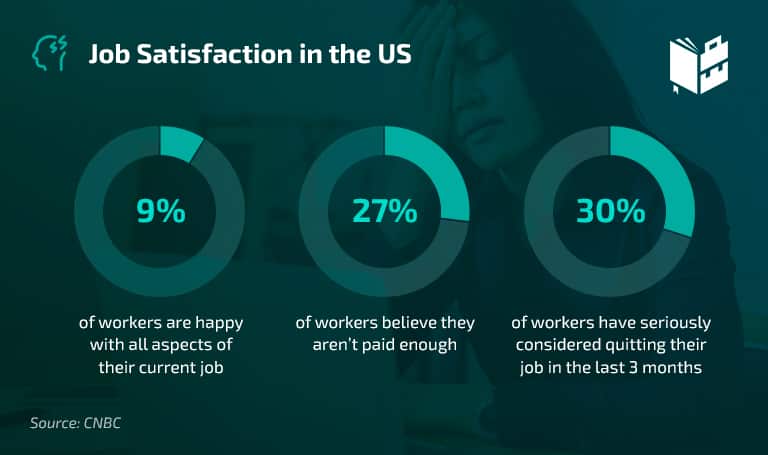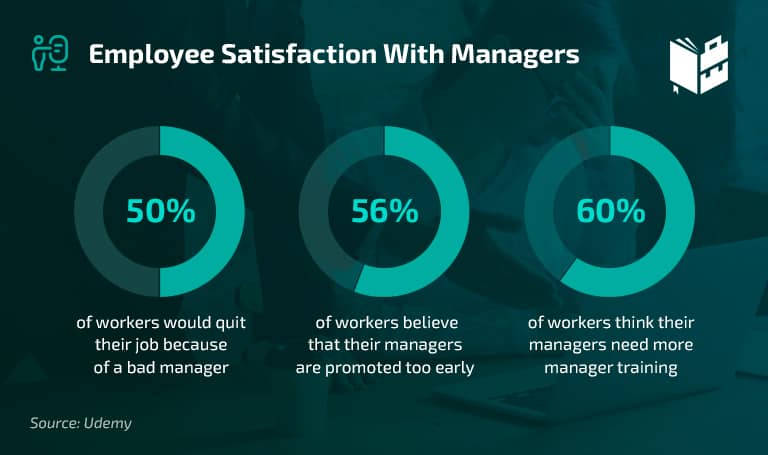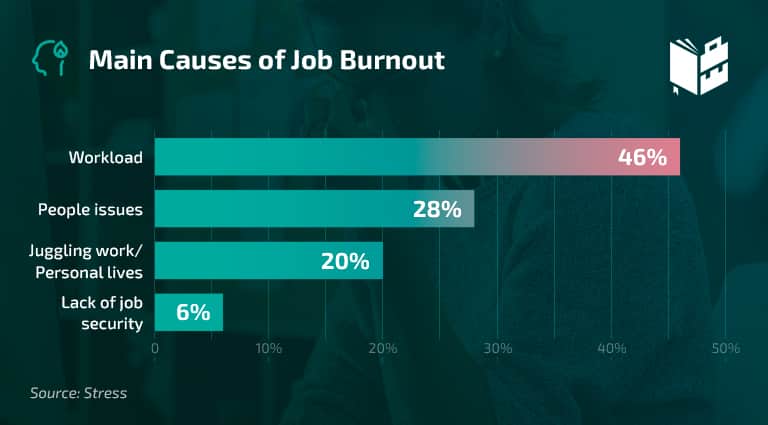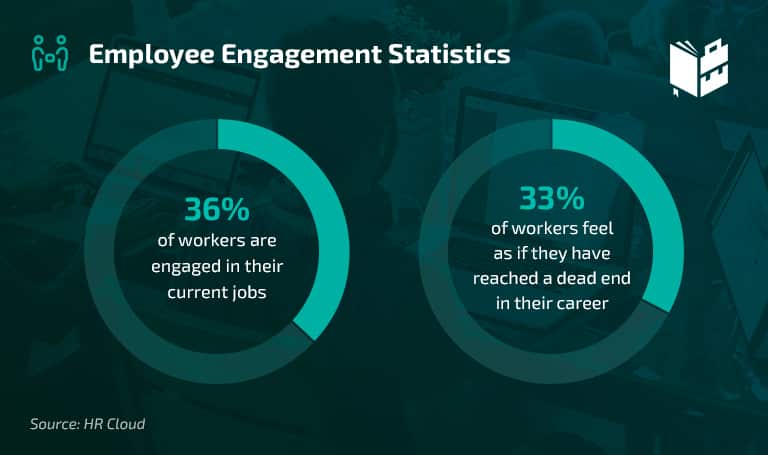Having a job and being happy with it are two different things. Over the years, a massive amount of research has been conducted on this topic. Thanks to this, we now have access to all sorts of job satisfaction statistics.
In fact, the focus of all those studies was on the correlation between job satisfaction and job productivity. Of course, we all have our own perception of satisfaction and what it should look like.
The use of specific criteria can allow us to collect relevant and valuable information on the situation in an average workplace. Find out more about job satisfaction.
Top Employee Satisfaction Statistics (Editor’s Pick)
- 65% of US workers feel satisfied with their current job positions.
- 47% of the US workforce works in low-paid occupations.
- 61% of workers think trust between them and the management leads to higher job satisfaction.
- Two out of five employees leave their jobs because of a bad manager.
- 37% of workers quit because of low salaries.
- 46% of US workers would leave their job because managers didn’t appreciate them.
- Engaged teams bring 23% more profit.
- Only 32% of US employees are engaged in their current positions.
About Job Satisfaction in the US
1. 65% of US workers are satisfied with their current jobs.
(Apollo Technical)
According to research, 65% of workers feel satisfied with their jobs. In fact, it seems that overall job satisfaction is on the rise, and the upward climb has been running for the seventh straight year.
With the increase in job security and especially the wages, the situation looks optimistic for the economy, as job satisfaction statistics confirm themselves. However, around half of the working population is not satisfied with their job, which leaves a lot of room for improvement.
2. Only 7% of workers have scored top marks on the Workplace Happiness Index.
(CNBC)
In a study conducted on 9,254 employees in the US, it was discovered that only 7% of workers are happy with their current position. In other words, only a handful of employees in the US are going to work with smiles on their faces.
The criteria for measuring these US job satisfaction statistics are opportunity, autonomy, meaning, pay, and contribution.

3. Around 47% of the US workforce works in low-paid jobs.
(Brookings)
One of the primary reasons for workers’ potential dissatisfaction is low salaries. In fact, according to these labor statistics in the US, almost half of the workers have a median wage that’s less than $15 per hour.
Needless to say, job satisfaction statistics by profession may vary. In other words, workers in different occupations may have differing opinions about their salaries.
4. 58% of workers with a household income of at least $75,000 report they’re satisfied with their salary.
(WSJ)
Speaking of salary, workers whose household income per year amounts to at least $75,000 are satisfied with their paycheck. In a way, this tells us a lot about their overall feelings about the job they do. This job satisfaction data is derived from the Conference Board job satisfaction report.
Also, Americans feel confident that their salaries will rise in the future. Once again, the connection between paycheck and job satisfaction comes to light.
5. According to 61% of workers, trust between them and the management plays a significant role in job satisfaction.
(SHRM)
As we all know, relationships between employees and their senior managers are not always good. Yet, 33% of workers in the US said that they are very satisfied with the relationship they have with their managers.
According to statistics on job satisfaction, people in charge will have to build a better relationship between themselves and the employees. For instance, 61% of employees agree that trust is a major factor in developing a healthy working atmosphere.
Without trust and mutual understanding, members of a particular organization can not be at their best. That affects the workflow and the subsequent profits of the company in question.
Employee Retention Statistics and Facts
6. 40% of employees wanted their managers to ask them how they were doing during the coronavirus pandemic.
(HBR)
All sorts of factors can influence the atmosphere within a collective. For example, remote work statistics reveal that more people work from home this year. However, the nuances of successful man management are of the utmost importance for employee retention stats. Unfortunately, around 40% of people report that their managers didn’t ask them if they were doing well. Furthermore, 38% of this group experienced a decline in their mental health.
7. More than two in five workers leave their job because of a bad manager.
(GoodHire)
According to a recent study, more than 40% of employees would quit their job because of a bad manager. So one of the main reasons for changing a company comes from having bad relations with senior managers and executives. Despite this and the fact that 61% of workplace bullies are bosses, US workers report the highest job satisfaction rate since 2005.

8. 60% of managers need more managerial training.
(Udemy)
Better managers should be able to provide better working conditions for their employees. Two-thirds of American workers are not entirely happy with the skills of those in charge of their organizations.
To be more precise, 56% of them believe that their managers are promoted too early. Also, 60% of US workers said that their managers should undergo additional managerial training. In theory, this could boost job satisfaction rates in the US.
9. 46% of US workers leave their jobs because of a lack of appreciation.
(GOBankingRates)
Recognition is also an essential factor when it comes to career satisfaction statistics. Judging from the results of an extensive research study, almost half of US workers have left a company because of a lack of appreciation. So if workers are not feeling valued and recognized for their efforts, they are likely to quit the job.
Again, managerial skills are at play here. In other words, managers should provide their employees with validation to continue with their hard work.
Stats on Job Satisfaction by Career
10. 37% of employees cite low salaries as one of the major reasons behind quitting.
(Pew Research)
According to a recent Pew Research survey, 37% of employees who quit their jobs in 2021 said low salary was one of the major reasons for quitting, while 26% listed it as a minor reason. The same job satisfaction statistics also show that the main reason for 33% was no opportunity for advancement, while 35% quit because they felt disrespected at work.
11. 53% of employees in America who left their work in 2021 changed their careers.
(Pew Research)
More than half of the US workforce changed their jobs in 2021. Furthermore, a recent job satisfaction study has shown that many employees who made this decision were those younger than 30 and people without a postgraduate degree.
Once again, this could be taken as a red flag for the bosses and executives. It is never a good thing to see your workers go and work for your competitors.
Workplace Statistics — Stress and Burnout
12. 52% of the US workers said they experienced job burnout in 2021.
(Forbes)
Researchers have discovered that more than half of American workers reported signs of job burnout in 2021. Employees who worked from home were more likely to experience burnout, but another study showed they were also putting in more hours than before the pandemic.
The common causes included a poor work-life balance, difficulties in taking time off, and a lack of boundaries. In a nutshell, workplace stress seems to be on the rise.
13. Workload is the primary cause of job burnout for 39% of Americans.
(Stress)
Unhappy employees statistics show that anxiety is the main symptom of job burnout. Moreover, almost 40% of Americans report workload as the main cause of stress. Nevertheless, interpersonal issues aren’t far behind, as 31% of people struggle with them.
Also, 19% of workers struggle with balancing their work and private life, while only 6% of them report the lack of job security as a big problem.In a way, this presents the darker side of employee satisfaction statistics. As such, all relevant parties should tackle the problem as soon as possible.

14. 44% of employees report experiencing high stress levels the previous day.
(Gallup)
A recent survey on employment statistics discovered that almost half of employees experience high stress levels daily. Moreover, 60% of the survey respondents claim they were “emotionally detached,” while 20% say they feel “miserable.”
15. 61% of workers make lifestyle changes in agreement with their company’s wellness policy.
(Aflac)
Depression, anxiety, and all sorts of aches and pains can significantly affect job satisfaction and productivity. For that reason, many companies are implementing so-called wellness programs. These programs are ’forcing’ workers to take some time away from work. For instance, to go on a vacation on a regular basis.
It seems that almost two-thirds of workers (61%) have decided to accept the guidelines. To clarify, they are making healthier choices in their lifestyle thanks to these programs.
Employee Engagement Statistics
16. Engaged teams are 23% more profitable.
(Gallup)
People who come to work with passion and energy are the ones who can move a company forward. Every company owner in the world wants their organization to thrive and grow as much as possible. In a nutshell, employees who feel good at their job are more likely to show up for work in the first place.
17. Employee engagement statistics indicate that only 32% of employees are engaged in their current jobs.
(Gallup)
When it comes to employee satisfaction statistics in the US, it is important to note that around 17% of workers feel actively disengaged at work. Moreover, less than a third of the working population (32%) say they are engaged at work. Data from the previous years shows that this percentage stood at 36% in 2020 and 34% in 2021.

Job Satisfaction Statistics — Conclusion
In conclusion, there is a lot of room for improvement. But the overall economic growth should result in more job opportunities. New job openings will create a stronger economy. As a consequence, we can expect some optimistic job satisfaction news in the upcoming period.
Then again, it is important to remember that job satisfaction is a subjective and personal matter. In other words, statistical data may send the wrong picture. As long as there are jobs, there will be people who complain. So the best course of action is that we all do our best in our day-to-day activities.